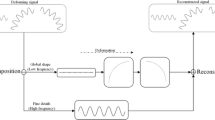Abstract
This paper presents an efficient compression algorithm for animated three-dimensional (3D) meshes. First, a segmentation approach is applied to achieve the motion estimation. The main idea is to exploit the temporal coherence of the geometry component by using the heat diffusion properties. The motion of the resulting regions is accurately described by 3D affine transforms. These transforms are computed at the first frame to match the subsequent ones. Second, in order to achieve a good compression performance, an efficient rate control mechanism is proposed to quantize the temporal prediction errors. At this stage, a rate-distortion model is used for quantizing the residual information. Comparative coding tests, for irregular 3D mesh sequences, were conducted to evaluate the coding efficiency of the proposed compression scheme. Simulation results show very promising performances.




Similar content being viewed by others
References
Lengyel, J.: Compression of time-dependent geometry. In: ACM Symposium on Interactive 3D Graphics, pp. 89–96 (1999)
Mamou, K., Zaharia, T., Prteux, F.: Multi-chart geometry video: a compact representation for 3D animations. In: IEEE 3DPVT, pp. 711–718 (2006)
Alexa, M., Müller, W.: Representing animations by principal components. Comput. Graph. Forum 19(3), 411–418 (2000)
Karni, Z., Gostman, C.: Compression of soft-body animation sequences. Comput. Graph. 28, 25–34 (2004)
Lee, P.F., Kao, C.K., Tseng, J.L., Jong, B.S., Lin, T.W.: 3D animation compression using affine transformation matrix and principal component analysis. IEICE Trans. Inf. Syst. E90-D 7, 1073–1084 (2007)
Müller, K., Smolic, A., Kautzner, M., Eisert, P.: Rate-distortion-optimized predictive compression of dynamic 3d mesh. Signal Process. Image Commun. 9, 812–828 (2006)
Payan, F., Antonini, M.: Temporal wavelet-based compression for 3D animated models. Comput. Graph. 31, 77–88 (2007)
Váša, L., Skala, V.: Coddyac: connectivity driven dynamic mesh compression. In: 3DTV Conference, pp. 145–154 (2007)
Bici, M.O., Akari, G.B.: Improved prediction methods for scalable predictive animated mesh compression. J. Vis. Commun. Image Represent. 22, 577–589 (2011)
Valette, S., Chaine, R., Prost, R.: Progressive lossless mesh compression via incremental parametric refinement. Eurograph. Symp. Geom. Process. 28(5), 1301–1310 (2009)
Shinagawa, Y., Kunii, T., Kergosien, Y.: Surface coding based on morse theory. IEEE Comput. Graph. Appl. 11(5), 66–78 (1991)
Tierny, J., Vandeborre, J.P., Daoudi, M.: Enhancing 3D mesh topological skeletons with discrete contour constrictions. Vis. Comput. 24, 155–172 (2008)
Belkin, M., Sun, J., Wang, Y.: Discrete Laplace operator on meshed surfaces. In: Proceedings of SOCG, pp. 278–287 (2008)
Hsu, E.P.: Stochastic Analysis on Manifolds. American Mathematical Society, Providence (2002)
Meyer, M., Desbrun, M., Schroder, P., Barr, A.H.: Discrete Differential Geometry Operators for Triangulated 2-manifolds. In: Visualization and Mathematics III, pp 35–57. Springer, Berlin, Heidelberg (2003)
Taubin, G.: Estimating the tensor of curvature of a surface from a polyhedral approximation. In: International Conference on Computer Vision, pp. 909–907 (1995)
Krongold, B.S., Ramchandran, K., Jones, D.L.: Computationally efficient optimal power allocation algorithm for multicarrier communication systems. In: Proceedings of International Conference on Communications, pp. 1018–1022 (1998)
Mamou, K., Zaharia, T., Preteux, F.: FAMC: The mpeg-4 standard for animated mesh compression. In: 15th IEEE International Conference on Image Processing, pp. 2676–2679 (2008)
Stefanoski, N., Ostermann, J.: Spatially and temporally scalable compression of animated 3D meshes with MPEG-4/FAMC. In: Proceedings of the IEEE International Conference on Image Processing, pp. 2696–2699 (2008)
Collins, G., Hilton, A.: A Rigid Transform basis for animation compression and level of detail. In: ACM Symposium on Interactive 3D Graphics, pp. 21–29 (2005)
Müeller, K., Smolic, A., Kautzner, M., Eisert, P., Wiegand, T.: Predictive compression of dynamic 3D meshes. IEEE Int. Conf. Image Process. 1, 621–624 (2005)
Briceno, H.M., Sander, P.V., McMillan, L., Gortler, S., Hoppei, H.: Geometry videos: a new representation for 3D animations. In: ACM Siggraph Symposium on Computer Animation, pp. 13–146 (2003)
Váša, L., Skala, V.: COBRA: compression of the basis for PCA represented animations. Comput. Graph. Forum 28(2), 1529–1540 (2010)
Author information
Authors and Affiliations
Corresponding author
Rights and permissions
About this article
Cite this article
Hachani, M., Zaid, A.O. & Puech, W. Segmentation-based compression scheme for 3D animated models. SIViP 10, 1065–1072 (2016). https://doi.org/10.1007/s11760-015-0859-0
Received:
Revised:
Accepted:
Published:
Issue Date:
DOI: https://doi.org/10.1007/s11760-015-0859-0




